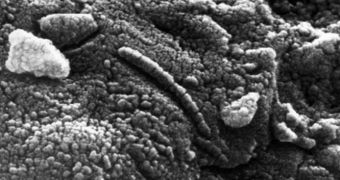A new twist in an established theory argues that all life on Earth may have developed from the remains of dead alien viruses, that arrived here on comets and other space impactors. This is a new form to the old idea of panspermia, which says that life did not originally develop here.
Some experts now believe that viruses from outer space made their way here the same way water did, by hitching a ride on comets and asteroids. They may have not survived the reentry process or the harsh conditions of early Earth, but none of that is really relevant.
It could be that, even after dying, the viruses still contained sufficient information to allow for life as we know it to appear and subsequently develop. This idea is gaining increasing numbers of adepts every day.
Back in the 1870s, Lord Kelvin first proposed panspermia, saying that meteors or comets brought microbes on our planet. Other scientists proposed that microscopic organisms made their way here on small dust grains, which permeate the Universe.
On top of these lifeboats, the organisms may have laid dormant until the slight pressure of solar winds in the intergalactic medium sent them in the direction of the solar system, where they found a new home on Earth.
But some investigators do not agree with this idea, saying that violent cosmic rays would have made short work of any microbe. “That essentially kills panspermia in the classical sense,” explains SETI Institute astrobiologist Rocco Mancinelli.
But an astronomer does not agree with this conclusion. He says that, even if pronounced dead on arrival, the microbes may have still contained enough data to kick-start the evolution on life on Earth.
The astronomer is a visiting researcher at the Herzberg Institute of Astrophysics in Canada. Paul Wesson says that the new theory, called necropanspermia, provides an elegant explanation as to how life appeared here.
The expert authored a research paper on the issue, which is scheduled to get published in an upcoming issue of the journal Space Science Reviews, Wired reports.”The vast majority of organisms reach a new home in the Milky Way in a technically dead state,” Wesson says.
“Resurrection may, however, be possible,” he goes on to say, adding that the determining factor in all of this is the amount of genetic information in the microbes that makes it through the long and dangerous trip.
But Mancinelli does not believe in the new idea. He says that, in addition to radiation, there are also two other processes that need to be considered a threat to microbes making the long journey.
First, the chemical potassium is known to decay over billions of year – which is how long it takes to cross just one galaxy – a phenomenon that would affect microbial DNA extensively.
The second is a process called dessication, but which is a bit more than simply drying up. In the harsh conditions of space, hydrogen and hydroxyl molecules get thorn out of their respective places, and combine to form water.
As this happens. “you denature proteins. You rip them apart, recombine them, and they no longer have any functionality. That can happen even if you’re in a rock.” the SETI expert explains.
“Going from Earth to Mars, not a problem. Even going from Earth to Pluto, or from Pluto to Earth, not a problem. But once you start heading out of the solar system, it’s so far away that it takes a long time,” he adds.
“That’s the thing, the length of time,” Mancinelli concludes.

 14 DAY TRIAL //
14 DAY TRIAL //